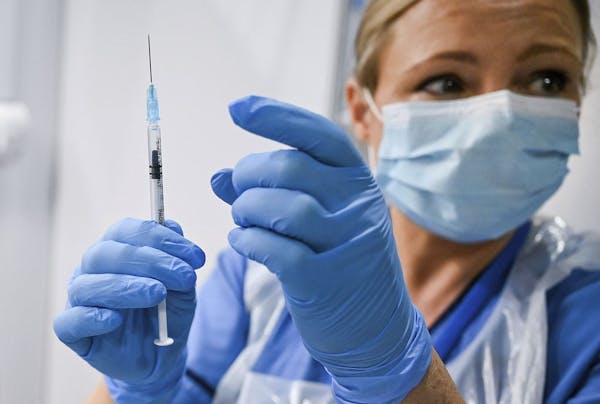More than 900,000 doses of COVID-19 vaccine have been administered in Minnesota, giving it the 22nd fastest rate of vaccine administration when compared by the U.S. Centers for Disease Control and Prevention to other states.
Minnesota on Monday reported that 675,329 people have received at least first doses of two-dose COVID-19 vaccines, and that 238,104 of them, or 35%, have completed the series.
The state prioritized initial quantities of federally controlled COVID-19 vaccine for a group of more than 1.5 million people in Minnesota who are health care workers, long-term care residents, senior citizens or educators. Roughly 44% of first doses of the Pfizer and Moderna COVID-19 vaccines have been administered to people 65 and older who are at elevated risk of severe COVID-19 illness.
Broad public access to vaccine isn't expected for weeks in Minnesota, which on Monday also reported a total of 6,378 COVID-19 deaths and 474,169 people known to be infected with the novel coronavirus that causes the disease.
The totals include two deaths reported Monday and 611 newly diagnosed infections — relatively low totals that reflect reduced reporting of COVID-19 activity over the weekend, and an actual decline in viral spread.
The state late last week reported that the positivity rate for diagnostic testing had fallen to 3.9%, below Minnesota's caution threshold of 5%.
Despite this good news, Health Commissioner Jan Malcolm said, the state must vaccinate as many people as possible. Viral spread could increase again, she warned, especially with the emergence of more infectious variants of the SARS-CoV-2 virus.
"We are in a race against time," Malcolm said.
Minnesota took a series of steps in late January to accelerate its pace of vaccine administration, opening up access to senior citizens and offering vaccine at state-operated sites rather than just local hospitals and medical facilities.
The state's rate of vaccine administration per 100,000 people rose from 45th at one point last month to 22nd, according to CDC tracking data.
Most states have achieved comparable vaccine administration rates in February, making the difference in rankings somewhat negligible. However, a handful of lower-population states, including North Dakota and South Dakota, have continued to outperform the rest of the nation.
Before the hearing was postponed Monday, Minnesota lawmakers had been scheduled to hear testimony from the leaders of one of the fastest states: West Virginia, which relied on small, independent pharmacies to vaccinate the priority group of long-term care residents.
West Virginia also features a preregistration site for all residents 16 or older to sign up for vaccine and to receive regular updates about when shots might be available.
Minnesota health officials said earlier this month they are developing similar online resources. The state created a registration site for its initial vaccine clinics, but closed it after 220,000 senior citizens signed up. The state now is using that waitlist to make appointments for senior citizens at its vaccine centers in Minneapolis, Duluth and Rochester.
The bulk of vaccine is being distributed in Minnesota through medical providers, who are scheduling appointments for elderly patients, though more doses are being routed to retail pharmacies as well. Teachers and others are largely gaining access through county public health vaccine events.
Jeremy Olson • 612-673-7744

Minnesota music legend Spider John Koerner dies at 85

Reusse: What a life it was for Bob Bruggers

Minnesota Legislature races toward deadline with bonding, rideshare bills in question

Dispute over Ramadan hours leaves owner of Turkish cafe facing drop in business


